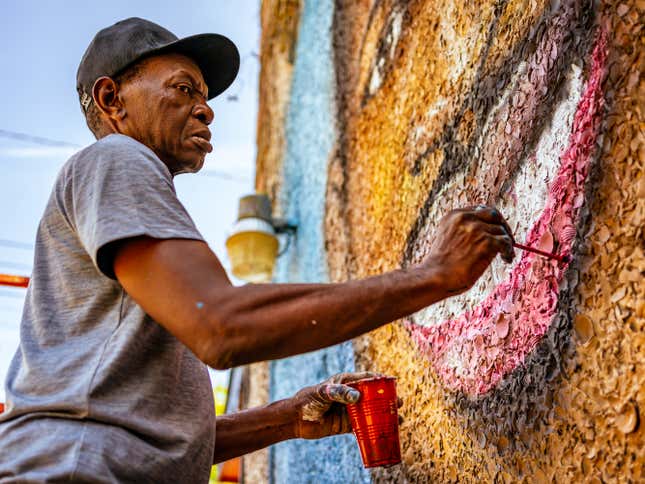
Last Sunday, hundreds of demonstrators met under a giant mural of Ahmaud Arbery in the coastal city of Brunswick, Ga., in order to push for justice prior to the jury selection in the trial against three white men accused of killing the Black jogger.
According to NPR, Marvin Weeks—a Black artist who grew up in Brunswick—painted the mural of Arbery that will serve as a symbolic place where community members can meet and discuss the issues of racial inequality that have plagued this country for so many years.
“I think that’s very important. A gathering place, you know, because my work really centers around neighborhoods,” Weeks told NPR. “Because there’s always a meeting place — a place to do the call and to talk about the issues that’s going on,” he added. “I think the mural does that.”
As jury selection continues this week, the 67-year-old artist is also hoping his artwork will inspire people to insist on a fair trial. Greg McMichael and his son Travis, along with their friend William Bryan, are on trial for shooting 25-year-old Arbery while he jogged through the Satilla Shores neighborhood of Brunswick. Bryan allegedly made a video of the shooting, which was made public months later, setting off national protests and demonstrations. According to USAToday, the court has accepted 23 juror candidates, but none have been seated as of yet.
Weeks painted the mural on a building that will soon be an African American cultural center. The stucco siding of the wall was made of lime and seashells, a process slaves brought from Africa. This connection to history, as well its location, makes Weeks’ mural even more special.
As a young adult, Weeks moved to Miami to pursue his career as an artist, but he still stays connected to the community where he was raised. According to the Brunswick News, Weeks created the mural as an ode to the neighborhood’s culture and rich history.
Since Arbery’s killing last year, Weeks has traveled to the Golden Isles more often, and wants to create more works of art for the city to highlight the area’s stories that may have been overlooked. According to NPR, he is currently working on an installation inspired by the Spanish-moss oak trees and salt marshes that he admired during his childhood. The artwork will pay homage to the legacy of Tunis Campbell.
“This is going to be an art piece for the entire Brunswick,” he told NPR. “It shows the history of Brunswick, and the African-American history is not disconnected from the general history.”
More on Campbell’s legacy, and Weeks’ ode to history through his art, per the NPR report:
“I’ve been researching Tunis Campbell and the legacy he left along the coast that people have kind of hidden and not talked about,” says Weeks.
Campbell was a key African American leader — a state senator and military governor for communities of formerly enslaved people on Georgia’s Sea Islands. Former slaveholders eventually ran them off the land.
Weeks says not acknowledging all that has happened here allows history to repeat itself. And that’s how he sees Ahmaud Arbery’s killing, a tragedy that was little known when it happened in February 2020.
Weeks is deeply connected to the mural of Arbery not only because of its location, but the story behind it. The three white men who allegedly followed Arbery in pickup trucks the moments before he was killed reminded Weeks of the events of racism he experienced as a child in Brunswick.
“When I was a child in this community, the pickup truck was a symbol of someone coming to harm you,” Weeks told CBS47. He recalled white people sometimes screaming at him, and even throwing objects.
“Everyone my age could tell you that was the fear when you saw a pickup truck coming,” he added.
Weeks believes that until people are able to have a genuine conversation about the issues of racism, there will continue to be problems.
“I think we’re continuing that old ‘everything is alright, show everyone from the outside everything is okay,’” Weeks told NPR of his neighborhood’s history. “It hasn’t been okay.”

